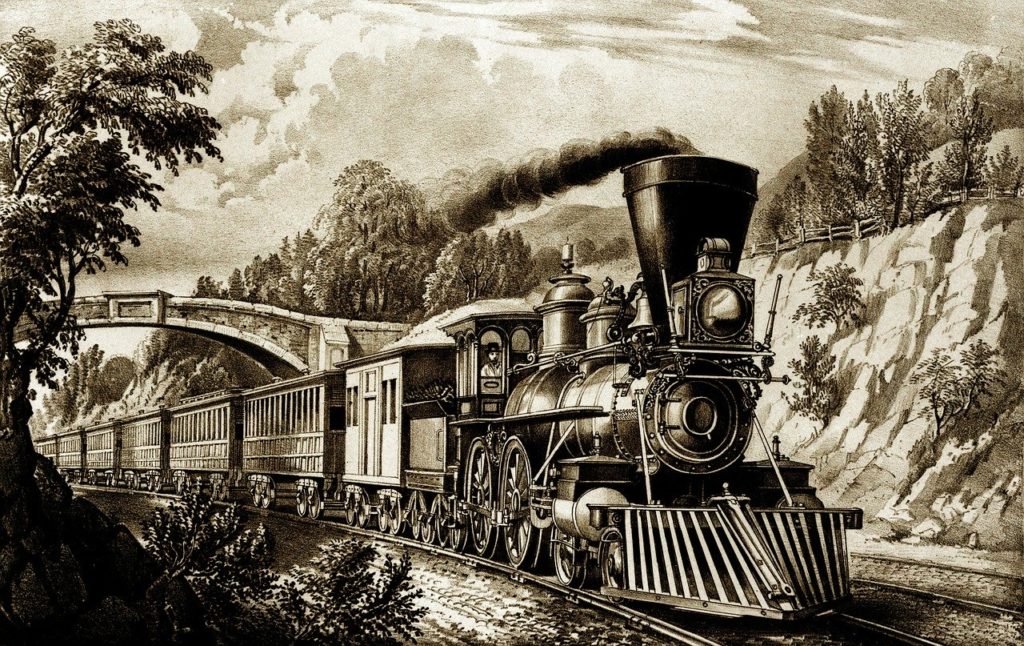James Watt, the famous Scot and great scientist, who vastly improved the imperfect steam engine of his day, is also referred to as the Father of Mechanical Engineering and Father of the Steam Age. In this post we will go through the life and times of James Watt from beginning to end.
First, if you’re looking to launch your own blog and start writing articles yourself, no matter what the subject, you can launch your blog with Bluehost for just $3.95/month.
Start creating content and launch your blog with Bluehost.
In 1736, George II was on the throne of Great Britain although Parliament had taken control of the legislative agenda since the revolutionary acts of the late 17th and early 18th century. It was now the dominant force in the land, Sir Robert Walpole was the Prime Minister of Great Britain and was the first man to hold the office. It was a constitutional upheaval and the balance of power had definitely shifted.
Hundreds of miles away from Westminster and far away from the political struggles of the day, James Watt was born in the lowlands of Scotland. His parents were respected members of the community from distinguished and well-educated families.
They would have had high expectations for their son, what they could not have imagined is that his name would become synonymous with power and he would come to be known as the Father of Mechanical Engineering. James Watt would become one of the giants of the Industrial Revolution and his inventions would redefine the British economy and infrastructure.
His legacy would reach down through the centuries that followed, far exceeding the fame he enjoyed throughout his life. How did this come about? What did James Watt do to write himself into history?
The Life of James Watt
James Watt was born on January 19th, 1736, in the Scottish town of Greenock and his parents were strong Presbyterians raised in a covenant. James Watt worked in both the shipping industry and local government whilst his grandfather was a teacher of math, navigation and surveying.
During his early years James was often unwell and his mother educated him at home for a few years until he was strong enough to attend the local grammar school. He was a bright child exhibiting an great talent for mathematics which would serve him well in later life.
After he left school he worked in workshops within his father’s companies, demonstrating extraordinary dexterity and ability while creating engineering models.
His mother passed away when Watt was just 18, and his father’s health also began to deteriorate, forcing Watt to look for training elsewhere. What seems to have been very important for him was his Calvinist religious background, where an emphasis was put on truth, hard work, avoiding waste and making yourself accountable before God.
He also became more scientific and gained what we might call enlightened forms of thinking when he spent time at the Glasgow University. He was never a student there but after he had spent some time in London advancing his scientific instrument training, he came back to Scotland and worked at Glasgow University as an instrument maker, repairing a lot of their small machines.

The academics there were extremely impressed by his skills, willingness to learn and knowledge. He learned a lot of the principles of heat, developed an understanding of gases and the importance of applying scientific knowledge to the real world.
Newcomen Engine
Watt had developed his scientific understanding of steam at Glasgow University where he repaired one of the Model Newcomen engines there. The Newcomen engines even in model form were appallingly inefficient, the big ones were inefficient and the little models by the time they got down to one that was about a meter high, had reached their limit. If the design was reduced any further it wouldn’t run at all and he was then asked to look at this engine which was just less than a meter high.
This engine wouldn’t run and they had even sent it down to London to a famous instrument maker to try to repair it, he failed and so Watt had a look at it. By very carefully checking it, cleaning it and making sure all of the pipes were clear, he finally managed to get it to run.
This was initially just for demonstration as it produced no power but it was at least then able to do what he was supposed to do, which was to demonstrate the movement of an engine to the students.
He then thought to himself that he is going to do a better job of sorting the engine out. He carried on working on another instrument for another year but the power of steam and it applications were now firmly lodged in his mind.
After cogitating on the subject for a year or two he suddenly thought to separate the cold bit at the engine (the condensing) from the hot bit (steam) and so he had two vessels a steam cylinder connected to a cold condenser, connected by a valve which could be operated by the engine.

That was a great breakthrough, he built a model and it worked and very rapidly, he could see that he will get twice as much power as before and an awful lot better efficiency from this engine.
Even with this potentially viable design, there were still significant issues with constructing a full-size engine. This is required more money which was hard to find, eventually financial aid came in the form of John Roebuck, of the famous Carron Iron Works, located near Falkirk.
With him they formed a working partnership, Roebuck lived at Canal House in Bowness and during that time Watt worked at perfecting the steam engine design in the cottage close to the house. Roebuck spent a great deal of money on Watt’s invention, but fell into bankruptcy before it became commercially viable.
With resources running low, Watt had no option but to find a job, first as a surveyor, then as a civil engineer (although he is primarily known for being the Father of Mechanical Engineering) for 8 years while he tried to perfect his steam engine.
Newcomen engines could put up with a pretty rough cylinder, Watt’s engine couldn’t. While Watt had made cylinders for his models, making a full size engine was quite beyond him. He wasn’t really getting much further, he tried all sorts of other ways of getting a smooth cylinder, for example making one by rolling sheet metal, but unfortunately these also failed.
In the meantime what he could do with all of his information was get a patent, to get the patent he had to travel up and down between Glasgow and London. During his travels at this time James Watt visited Birmingham for some supplies. Watt Intended this to be a routine stop, however having never been there before he was left astonished at the opportunities that were on offer.
Birmingham
Birmingham is a small market town with no great natural advantages, it hasn’t got a river, it’s not near the sea and it’s an unconstitutional town. It had no controls really so it was very welcoming to nonconformists and basically non-Anglicans. Anyone could make a living in Birmingham and that’s what made it quite unusual.

During his visit Watt was introduced to the Lunar Society of Birmingham, a dinner club in an informal society of prominent learned figures in the area. The Lunar Society were a group of men, they were completely disorganized, there was no formal agenda, there were no formal minutes and it was basically a group of friends with common interests, the main interest being science.
Science was referred to as natural philosophy and it was about studying, empirically recording your notes and correspondence. They met by the light of the full moon and that enabled them to find their way home more easily. The members of this group included; Matthew Boulton, who became Watt’s big business partner, and Erasmus Darwin, one of Charles Darwin‘s grandfathers.
Despite not yet living in Birmingham Watt continued an extensive correspondence with the Lunar Society and became an essential figure in their discussions. Watt’s financial difficulties continued and his personal struggles were exacerbated by the tragic death of his first wife Margaret Miller during childbirth.
Upon hearing this key members of the Lunar Society wrote to Watt urging him to move to Birmingham, one man Matthew Boulton was particularly keen with the transition.
Boulton & Watt
Boulton was a very attractive character, he was very engaging, had the gift of the gab and he was someone who was forever on the verge of bankruptcy because he was an entrepreneur and took risks. He built a massive factory, one of the biggest in the country, it cost far more than ever intended and there was no way that that business could sustain it.
It was then that he started to look for something that would be more profitable, and coming across Watt’s unrealized invention he saw that there was huge potential to produce the engine and have it running.
Through Boulton, Watt finally had access to some of the best iron workers in the world, they were able to assist with many of the technical problems that had been facing him. Boulton and Watt had formed a hugely successful company called Boulton and Watt, which would last for the next 25 years.
Both men were quite different, Boulton was an extrovert and Watt was the complete opposite, cautious and a worrier, he never wanted to do anything without totally being sure. That is another way that Boulton helped him, by speeding him up!
Watt Steam Engine
Using Boulton’s resources, Watt’s steam engine was finally fully realized and commercially viable, and the next step for the budding partnership was to begin the hunt for customers. The one advantage that Watt’s steam engine had was that it was much more efficient now, but that didn’t matter if the engine was to pump water out of coal mines, because there was plenty of coal there.
The Newcomen engine could be repaired by a blacksmith and carpenter, but the Watt steam engine couldn’t. However, in Cornwall the advantage of the Watt steam engine proved its effectiveness because Cornwall didn’t have any coal, so coal had to be imported long distances which added to its expense.
The Watt steam engine could reduce that demand for coal and therefore the first regional take off of the Boulton and Watt steam engine was in Cornwall. Watt was also very effective at preventing other potential steam engine invaders from muscling in on his designs, and was always operating within a commercial and competitive environment.

The success of the business meant the Watt had to explain to customers the benefits of his engine, particularly the amount of power that they could generate. To do this, he coined the term horsepower which has lasted to this day.
When people asked him how powerful the machine was, he said it would replace X number of horses. The term has been given more accurate measurements since but that term still applies today quantifying power with horsepower, a catchy term which helps to visualize power.
During this time Watt met his second wife Anne McGregor with whom he would remain with for the rest of his life. However the illnesses that plagued him since he was a small child never fully dissipated and he continued to suffer with headaches and depression throughout his adult life.
Despite these demons and with no small thanks to his support network, James Watt was able to continue making massive technological advancements with the steam engine, honing and refining his earlier work.
Watt developed another dimension to the steam engine, the rotary motion which enabled the up-and-down pumping engine to be transferred to a rotary motion which could be used to power machinery. That enabled the Watt steam engine to be used in factories to drive machinery.
By the 1790s the steam engine was becoming a successful commercial proposition and Boulton and Watt became wealthy, they were able in 1796 to secure the contract to construct the Watt Canal Pumping Engine.
The Soho Foundry was particularly famous for manufacturing steam engines, they manufactured the parts and the foundry was very close to a major canal network so that helped keep prices low and concentrating production.
Steam was something that captured peoples imagination and increasingly advanced into different aspects of life. Watt certainly can be seen as one of the individuals who contributed to the mature Industrial Revolution that was heavily dependent upon steam technology, and this was a major factor contributing to his title of “Father of Mechanical Engineering”.
Watt’s work with Boulton was strengthened by the teams that he had around him, and particularly through his relationship with the firms lead engineer and fellow inventor William Murdoch.
William Murdoch
William Murdoch like James Watt was a Scott, and legend has it that Murdoch walked all the way down from airship and knocked on Matthew Boulton’s door to ask him to give him a job. Whether that is true or not, it is true that Boulton and Watt soon acquired a lot of respect for Murdoch’s ability as a quick learner. He was able to translate Watt’s scientific ideas and knowledge into a reality.
Murdoch was useful as he was a great innovator himself, however he is never given any real credit for anything. It was only until 1800 that he got any credit due to all of the patents being in Watt’s name. Anything that Murdoch did as an employee he was paid to by Watt, and he did so by inventing the steam carriage.
Watt did not believe that this was a viable invention, he didn’t think it was physically possible. There wasn’t always complete agreement as Watt did not believe that the engine would pull its own weight never mind carriages behind it.
Watt called it a day on his work in 1800, the same year that his fundamental patents and partnership with Boulton ran out. He continued to work as an inventor during his retirement, maintaining his interest in civil engineering and was a consultant on several significant projects including a water pump under the River Clyde in Glasgow.
His famous partnership with Boulton was passed on to the men’s sons Matthew Robertson Boulton and James Watt Jr. William Murdoch was then made a partner in the firm and it continued to prosper.
The Father of Mechanical Engineering
Watt did lay down instructions for his death, that he wasn’t to have an elaborate funeral or elaborate monuments and that might reflect a degree of modesty.
However James Watt Jr. totally ignored the requests of the Father of Mechanical Engineering and went to the opposite extreme. Watt certainly had an ego but common thought is that he would be uncomfortable with the amount of adulation he now receives.
James Watt, the Father of Mechanical Engineering, died on August 25th, 1819 at his home in Heathfield Hall near Handsworth at 83 years old. He was buried on September 2nd in the graveyard at Saint Mary‘s Church.
Thanks to the enduring success of his company his son James Watt Jr. launched a huge campaign celebrating his fathers life and work as the Father of Mechanical Engineering.
James Watt’s creation of an efficient steam engine changed the industry and society for the better, it aided Great Britain in becoming the worlds first industrialized society which led to an extraordinary pace of economic growth and accelerated technological development across the world.
The accessibility of efficient reliable power made a variety of whole new classes of industry economically possible, and with it brought about great social change, bringing millions of rural families into the towns and cities.
His legacy as the Father of Mechanical Engineering has been solidified in history and public awareness of his life and the work remains high to this day.
Cutting through the legend to the man beneath may have been a difficult task at times but it cannot be doubted that James Watt played an enormous role in shaping the world we live in today.
Thank you very much for being here – we appreciate you taking the time to read our content. If you have anything to add, please feel free to leave a comment down below, and sign up to our newsletter for more of the same!
You can also follow us on LinkedIn, Facebook, Twitter, and Instagram so you can stay up to date.



